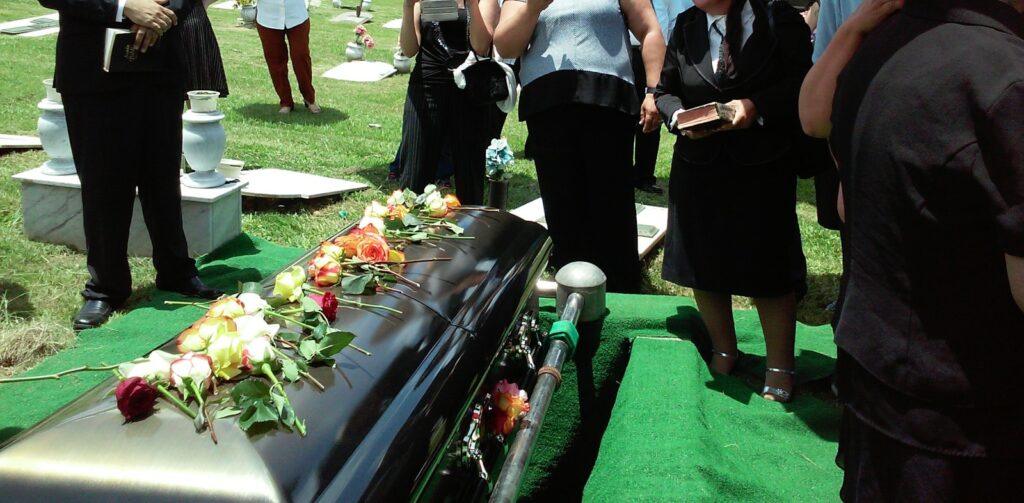When planning a funeral, one of the decisions you’ll encounter is whether to choose a casket or a coffin. While the terms are often used interchangeably, they refer to two distinct types of burial containers. However, there’s also a third option—choosing a shroud instead of a casket or coffin. Understanding the differences between these options can help guide you in making the best choice for your loved one.
What is a Casket?
A casket is a four-sided burial container, typically rectangular in shape, designed with hinged lids. Caskets are commonly used in North America, particularly in the United States and Canada. They are generally more elaborate and can be made from a variety of materials such as wood, metal, or fiberglass. The interior of a casket is often padded with soft fabric, offering a more refined and decorative appearance.
What is a Coffin?
A coffin is a six-sided burial container that tapers at the head and foot, with a wider middle to accommodate the body’s natural shape. Coffins are more common in Europe and other parts of the world, and their simpler, less ornate design is often seen as more practical or traditional.
Choosing Neither: Burial Shroud
For those seeking a more natural or minimalist approach to burial, a burial shroud is a viable option. A shroud is a piece of cloth used to wrap the body directly, without the use of a casket or coffin. This option is often chosen for green burials, which emphasize environmentally friendly practices.
Key features of a burial shroud include:
- Material: Typically made from natural, biodegradable fabrics such as cotton, linen, wool, or hemp.
- Simplicity: A shroud offers a simple, dignified way to prepare the body for burial, without the need for an elaborate container.
- Eco-friendly: Since shrouds are made of biodegradable materials, they decompose naturally, making them ideal for those who prioritize sustainability.
- Customization: Shrouds can often be customized with personal touches, such as embroidery or meaningful patterns, to honor the deceased in a special way.
Shroud burials often take place in green cemeteries or natural burial grounds, where the body is returned to the earth with minimal environmental impact. Some conventional cemeteries may also allow shroud burials, depending on local regulations.
How to Choose Between a Casket, Coffin, or Shroud
When deciding whether to choose a casket, coffin, or burial shroud, several factors should be considered:
Environmental Considerations
- If you are concerned about the environmental impact of burial, a shroud offers the most eco-friendly option, as it allows the body to decompose naturally with minimal materials involved. Shrouds are often used in conjunction with green burials, which forgo embalming and non-biodegradable materials.
- Caskets and coffins can also be made from sustainable materials, but the larger amount of material required to construct them makes them less environmentally friendly than a simple shroud.
Budget Considerations
- Shrouds are typically the most cost-effective option, as they do not require the craftsmanship and materials associated with caskets or coffins. Depending on the type of fabric and design, shrouds can be highly affordable.
- Coffins tend to be more budget-friendly than caskets due to their simpler design, while caskets can vary widely in price, depending on the materials used.
Cultural and Religious Traditions
- Shrouds are used in many religious traditions, including Jewish and Muslim burials, where simplicity and a direct return to the earth are emphasized. If your family or religious beliefs encourage a natural, humble approach to burial, a shroud may be the most appropriate choice.
- Caskets and coffins are more commonly used in Christian and secular funerals, though shrouds can also be integrated into these ceremonies.
Ceremonial Preferences
- If you plan to hold a viewing or funeral service where the body will be on display, a casket may be the preferred option due to its hinged lid and more polished appearance.
- With a coffin or shroud, viewings are less common, though families can choose to have a ceremony that centers around the body wrapped in a shroud before burial.
Aesthetic Preferences
- A shroud offers a minimalist, natural look that focuses on simplicity and reverence for the body. Families can choose shrouds in different colors or fabrics to reflect personal tastes or cultural traditions.
- Coffins and caskets come in a wide variety of styles, allowing for more personalization through material choices, colors, and intricate designs.
Shrouds in Green Burials
If you are interested in a green burial, choosing a shroud is a natural fit. Green burials are designed to minimize the ecological footprint of the funeral and burial process by avoiding embalming chemicals, metal hardware, or synthetic materials. Green cemeteries often prohibit the use of caskets or require biodegradable caskets or shrouds to ensure that everything used in the burial will naturally decompose over time.
Some green burial grounds allow bodies to be placed directly into the ground without a shroud or coffin, though many require at least a shroud for respectful handling and burial.
How to Choose
Ultimately, your decision between a casket, coffin, or shroud depends on personal values, budget, and the kind of farewell you wish to provide. If you prioritize environmental sustainability and a return to simplicity, a shroud may be the best choice. However, for those seeking a traditional ceremony or a more visually elaborate burial, a coffin or casket may align better with your preferences.
In any case, it is important to speak with your funeral director to understand the options available based on local regulations, cemetery policies, and your personal wishes.
See related: What is a sarcophagus and is it still used today?

